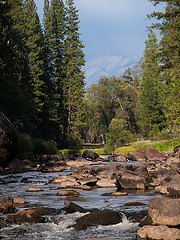Most everyone who participates in outdoor activities is also familiar with the need to stay properly hydrated because the human bodies’ cooling system is designed to operate via the process of evaporating moisture from the surface of the skin. But, finding fresh, drinkable, water in the outdoors can sometimes be a bit difficult; especially with the prevalence of invisible bacterial, viral, and protozoa contaminates such as Coliform Bacteria, Giardiasis, Cryptosporidosis, Hepatitis A .
Consequently, there are many manufactures in the market today who produce portable water filters of various types that enable us to filter our drinking water in the field before consumption.

However, most types of water filters are designed to remove only the above mentioned types of contaminates from the water and thus, they will only function with relatively clear water because the suspended silt and detritus that causes turbidity in water, as well as the dissolved salt that creates saltwater, clogs the microscopic pores of porous water filters. In addition, it is important to note that both chemical and UV water purifiers are often unable to penetrate turbid water thoroughly enough to kill microbial contaminates. Therefore, when choosing a water filter, it is important to note the difference between Porous Water Filters, Osmotic Water Filters, and Ultraviolet Water Purification Systems and make your choice accordingly.
Porous water filters –
Porous water filters are by far the most common type of water filter and they are readily available from many sporting goods and outdoor adventure stores. In addition, as the name implies, all porous water filters incorporate a solid, porous, material that is made from various materials such as silver impregnated ceramic with a given size of pathways that is usually measured in microns.
Consequently, they filter the water that passes through them by excluding any particle or microorganism that is larger than the opening of the pathway. However, in order to force the unfiltered water through the pathways in the filter, the user must employ one of several different methods to create pressure on the unfiltered side. Therefore, one type of porous water filter uses the force of gravity to start water moving through the filter which then creates a siphoning action which continues to move water through the filter while another type uses a hand-operated pump to create the necessary pressure to cause the water to move through the filter.
In addition, there are squeeze-bottle type porous water filters that use the pressure created inside of the bottle when it is squeezed to force the water through the filter and last, there are “straws” which use suction created by the users mouth to draw the water through the filter. However, it is important to note that the main purpose of a porous water filter is to remove harmful microorganisms from water and thus, if the water being filtered contains either suspended detritus or dissolved salt, it will cause the filter to clog (and thus need replacement) much more quickly than if it is only used with clear water.
Depending on the amount of debris in the water it may be worthwhile to pre-filter the worst of it out using a simple coffee filter, or even just a piece of woven fabric.
Osmotic water filters –
For those of you who are not familiar with the process of osmosis, it is defined as the process by which solvent molecules (in this case water molecules) spontaneously move through a permeable membrane to an area of higher solute concentration in the direction that tends to equalize the concentration of the solute. Therefore, Osmotic water filters work on the principal of either Forward Osmosis or Reverse Osmosis in which, instead of using gravity or kinetic pressure supplied by the user by squeezing the container to move water through the filter, a “syrup” is added to the reservoir to create a hypertonic solution that causes the water molecules to migrate through a permeable membrane without the input of energy from the user.
One such filter is made by a company called Hydration Technology Innovations and it was originally developed at the request of the U.S. Military to allow its troops to extract drinkable fresh water from any available source! Thus, in order to make this possible, HTI decided to employ the process of Forward Osmosis which enables their water filter to remove silt, detritus, salt, and microbial contaminates from even the most turbid of water sources. In fact, according to the HTI web site: “HTI’s revolutionary forward osmosis water filtration products were originally developed in cooperation with the US Department of Defense for soldier hydration. Funded by the Defense Advanced Research Projects Agency (DARPA), the goal of the project was to develop a means by which a soldier could drink any water found on the ground, no matter how contaminated. There were a number of water technologies involved in the project, but critical to meeting the goals of the military was the ability to work well with muddy or turbid water. DARPA understood that forward osmosis was the only technology that had the potential to work unimpeded in thick, dirty water”. Therefore, Forward Osmosis water filters are the perfect answer for outdoorsmen who have a need to desalinate sea water for drinking, cooking, and washing.
However, unlike other water filters in which drinkable water is available almost immediately because the water passes through the filter fairly quickly, osmotic filter systems are much slower to operate and thus, they require a certain amount of forethought and planning so that drinkable water will be available when you need it. Thus, it is important to note that in most cases, when using an Osmotic water filter, a twenty-four hour waiting period is required in order to produce fresh, drinkable, water. Also, each time you use the filter, you have to add a special “syrup” to the reservoir in order to create a hypertonic solution which causes the water molecules to migrate through the permeable membrane. In addition, unlike other water filters, the filter membrane must be replaced more often. Thus, a wise solution is to this dilemma is to carry a conventional water filter for use with clear water and an Osmotic Water Filter for use with turbid or saltwater.
Ultraviolet water purifiers –
Although not technically classified as a water “filter”, another type of water purification device that is gaining popularity with the gadget minded outdoorsman is the Ultraviolet Water Purification System which uses a UV-C discharge lamp in the bottle cap to render any bacteria, viruses, or cysts inside the water bottle inactive. To use this type of water purification system, the user simply depresses a button which activates the UV-C lamp in the lid and waits for the LED to indicate that the UV-C discharge cycle has ended and the exposure to the ultraviolet light kills any microorganisms living in the water.
In addition, the UV-C lamp is usually powered by an internal, rechargeable, battery that will last for up to 100 purification cycles before requiring recharging. However, it is important to note that UV water purification systems should only be used with clear water because any suspended detritus or sediment in the in the water will lessen the effectiveness of the system since less light will reach the microorganisms that you are trying to render inactive. These particles will also be left in the water at the end so will be in your drinking or cooking water.
So, as you can see, there are several different types of portable water filters available and each type employs a different method of water flirtation and/or water purification and each type also employs a different method to transport the water through the filter or membrane. Furthermore, portable water filters are available in numerous different sizes to meet your fresh water requirements and some even include an activated charcoal filter in addition to the main filter to remove unpleasant tastes caused by dissolved minerals in the water such as iron or sulfur. Last, portable water filters are available in a wide range of prices and thus, if you enjoy wilderness activities, then you should definitely consider purchasing a portable water filter because you never can tell when even a pristine water source is contaminated with microorganisms that are detrimental to your health.









[…] Choose portable water filter […]